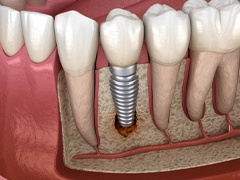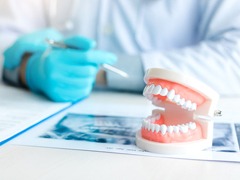Dental Implant Failure & Salvage – Torrance, CA
Timely Procedures to Save Your Smile
When dental implants are put into place, you can expect your results to last a lifetime with regular care and maintenance. In fact, when placed by a licensed professional, they have a 95% success rate. Their ability to improve your oral health, offer greater functionality, and boost your confidence makes them the “gold standard” for tooth replacement. There are cases, however, that can end in dental implant failure. Although it is extremely rare, should you experience a failed dental implant in Torrance, it’s best to see our team at Blue Coast Dental Group as soon as possible. Our in-house periodontist, Dr. Galvan, will take a look at your problem tooth and generate a treatment plan that incorporates dental implant salvage. Before you know it, you’ll be enjoying the many great benefits dental implants have to offer.
Why Do Dental Implants Fail?

There are many reasons a dental implant can fail but the most common is peri-implantitis. When an infection occurs in your gums, it will begin to destroy the soft tissues and bone surrounding your implant. This typically only occurs if you have a poor oral hygiene routine and develop what is known as gum disease.
Dental implant failure can also occur as a result of:
- Traumatic injury
- Osseointegration failure during recovery
- Certain medical disorders and diseases that can weaken the immune system (i.e., cancer, diabetes)
Symptoms of Failed Dental Implants

It is most common for dental implant failure to occur immediately following your surgery (during the recovery phase); however, problems can develop months or even years after you receive your permanent prosthetics. Early or late implant failure are the two different stages, both of which can and should be addressed the moment symptoms arise.
If you begin to notice any of the following signs, make sure to contact our office as soon as possible:
- Pain and discomfort after your surgical procedure. Although minor soreness is normal, the discomfort you experience should dissipate over time. If it does not, there is likely something wrong with your dental implants in Torrance.
- You experience difficulty eating and chewing your food. Dental implants should feel completely natural and act just like normal teeth, allowing you to eat without concern. However, should eating be a challenge, there’s a good chance implant failure has occurred.
- You begin to bleed, swell, and notice pus forming around your implants.
- One or more of your implants becomes loose, in which, we will need to closely examine the problem area to determine if it is the restoration or implant.
How Dental Implant Salvage Works

At Blue Coast Dental Group, we want to ensure the health and longevity of your smile, which is why you are advised to get in to see us as soon as possible should you notice there is a problem with your dental implants. Once we are able to thoroughly examine your oral cavity, we will identify the problem area and offer available treatments that will not only save your smile but also get you back to enjoying a new life with implants.
Depending on the severity of the problem, you may only need a deep cleaning that will essentially, save your dental implants. Antibiotics can also prove beneficial and effective. But it’s important to remember that if the infection is too severe and the tissues and bone are negatively impacted, we may need to remove your implant and allow you to heal. If the decision is to try and place a new dental implant, you may need to undergo bone grafting first to help strengthen this area of your facial structure.
